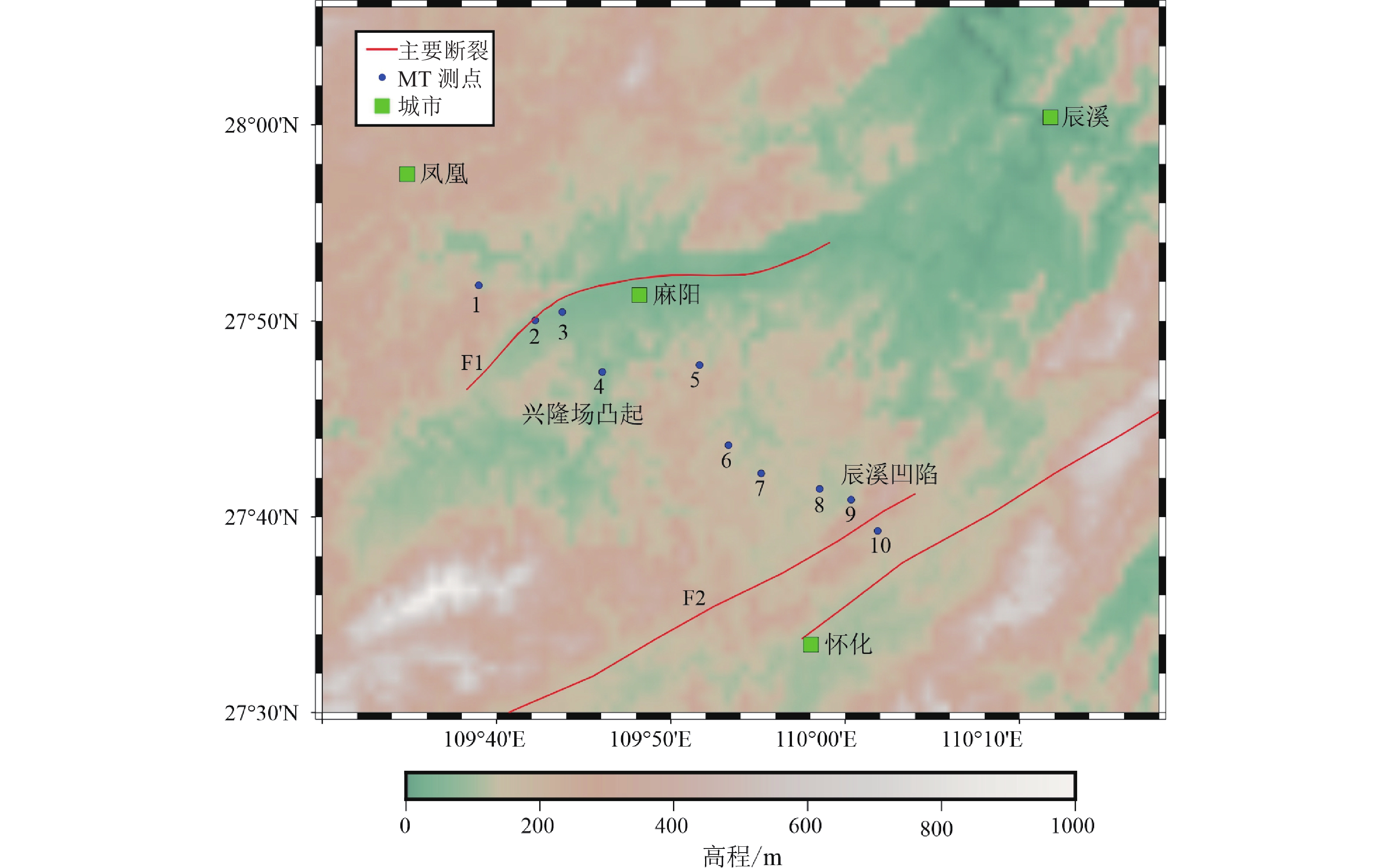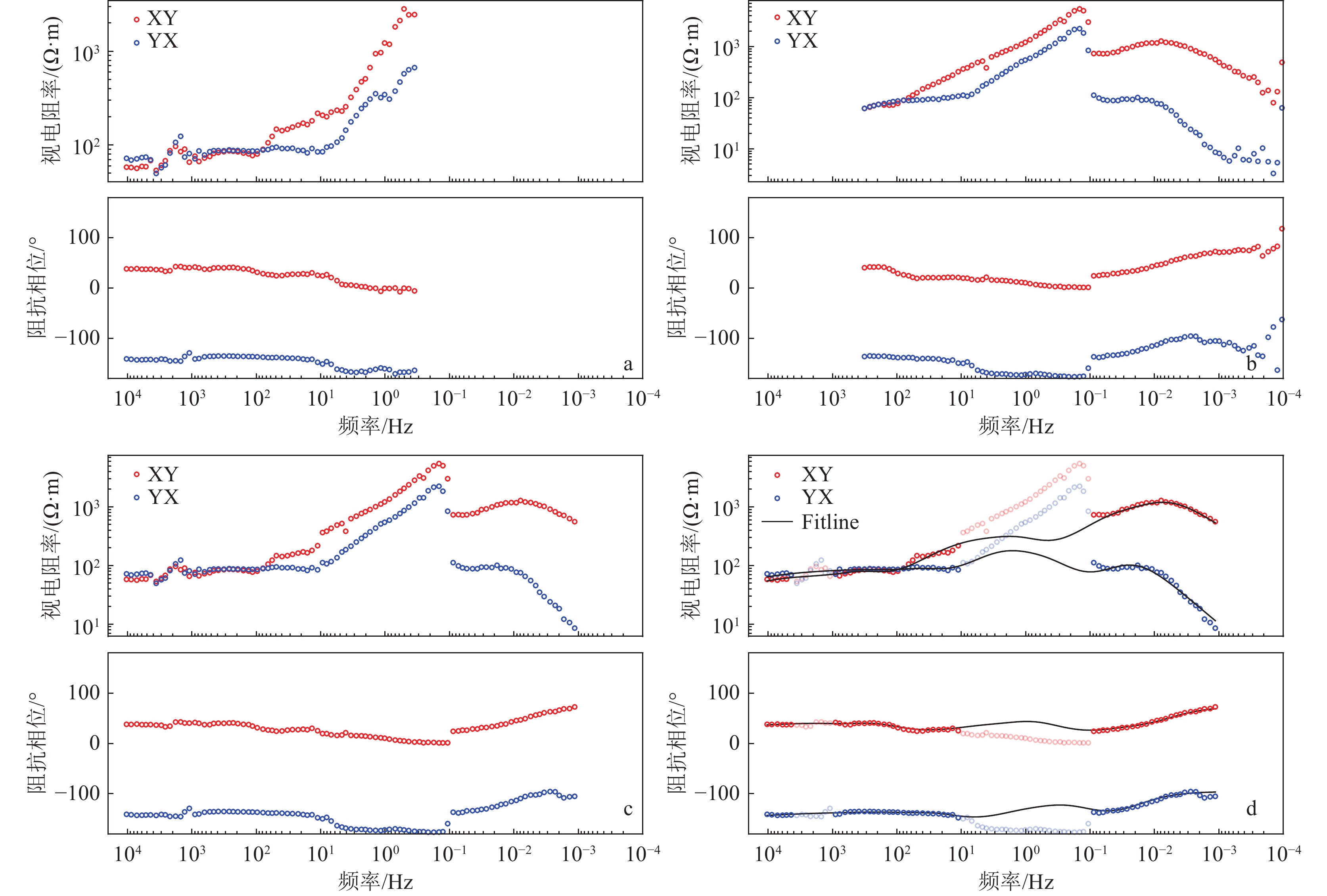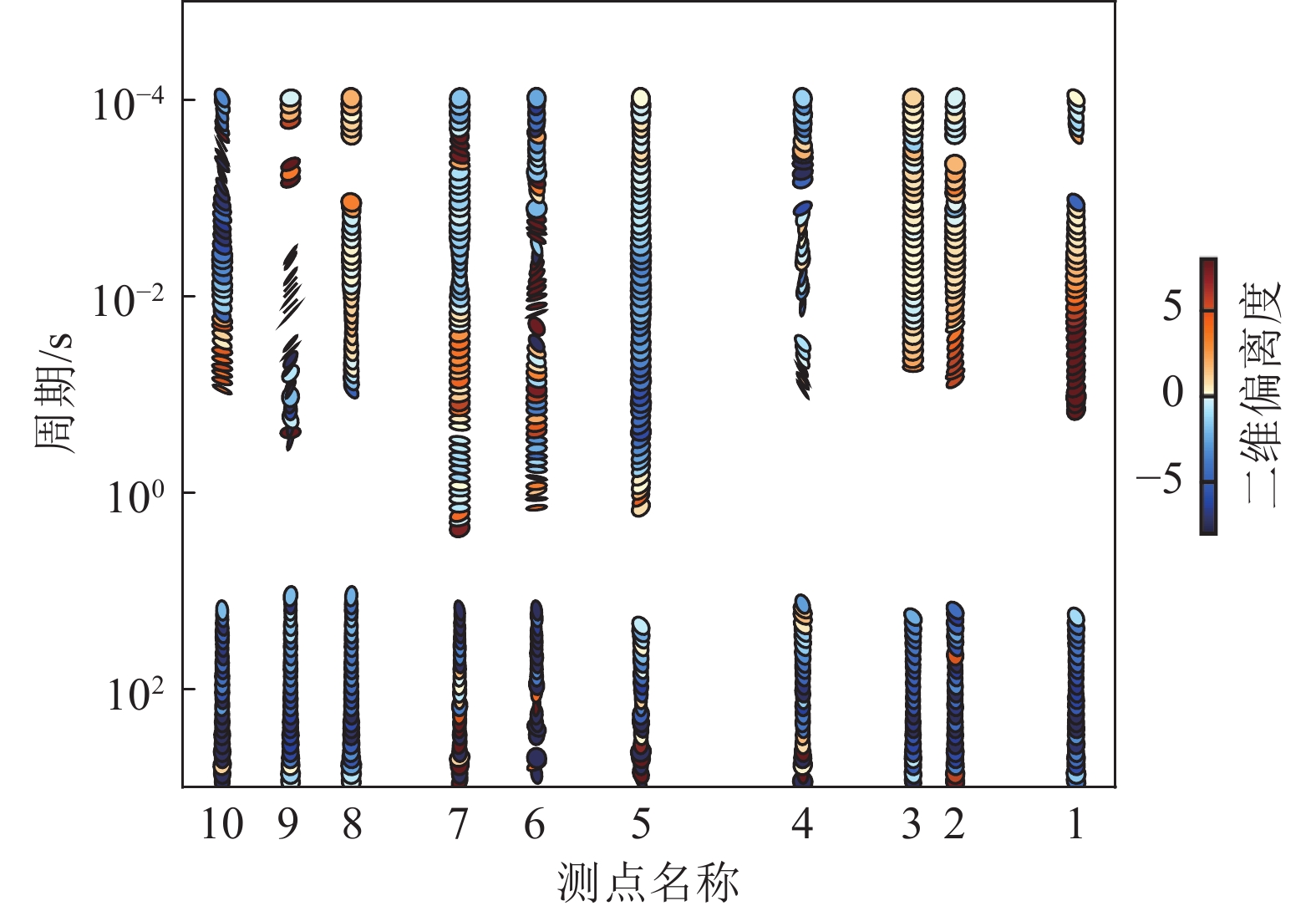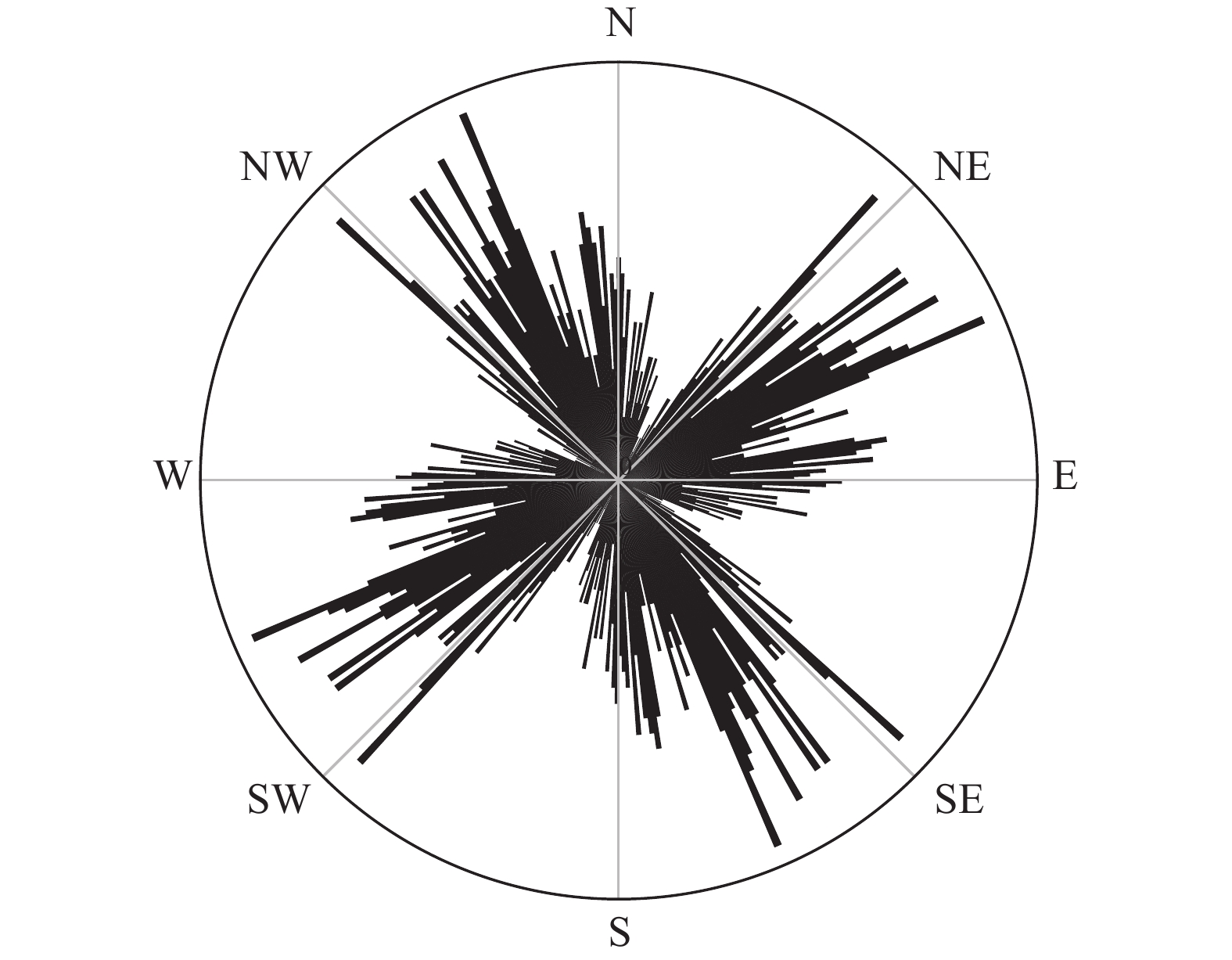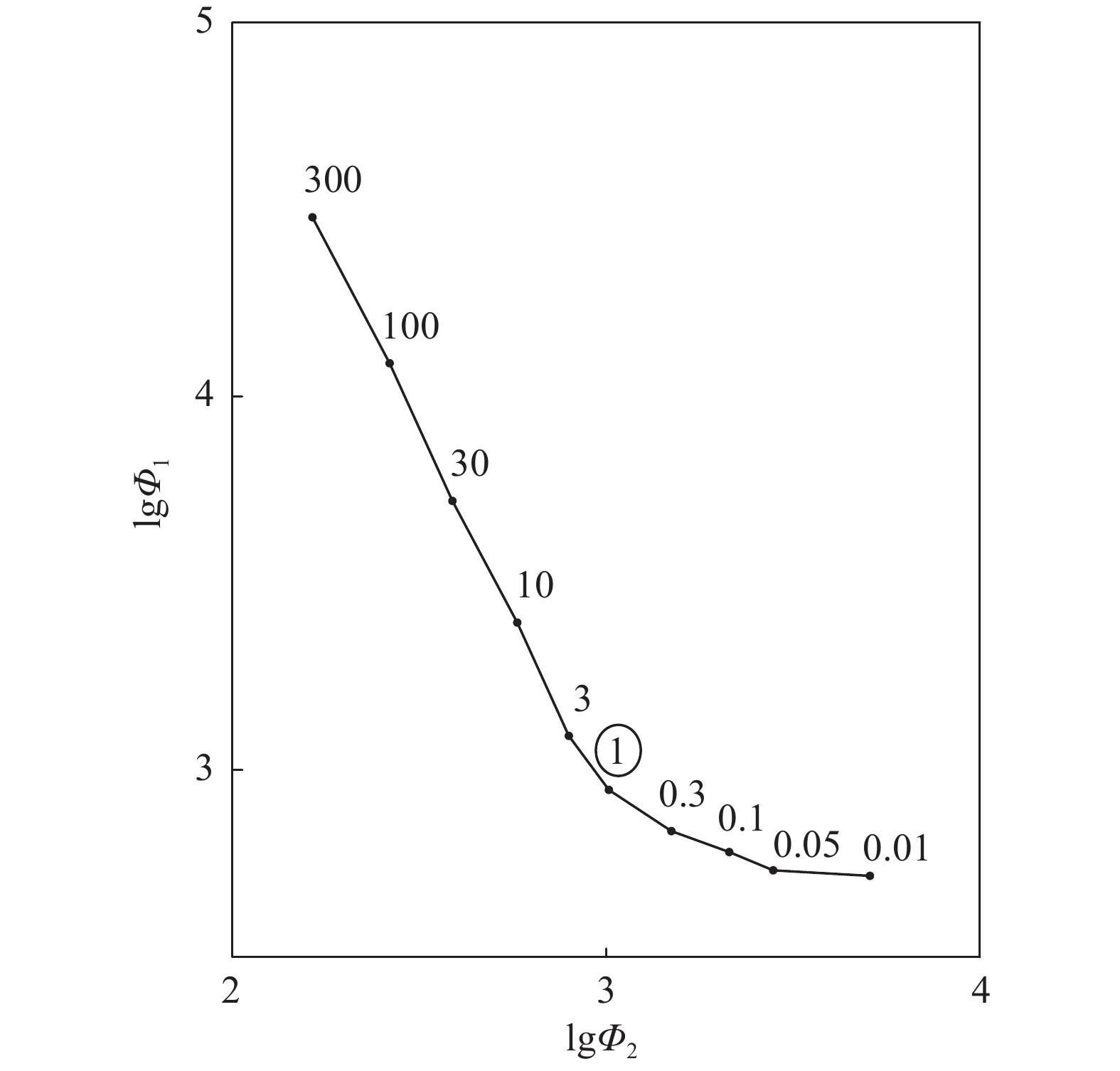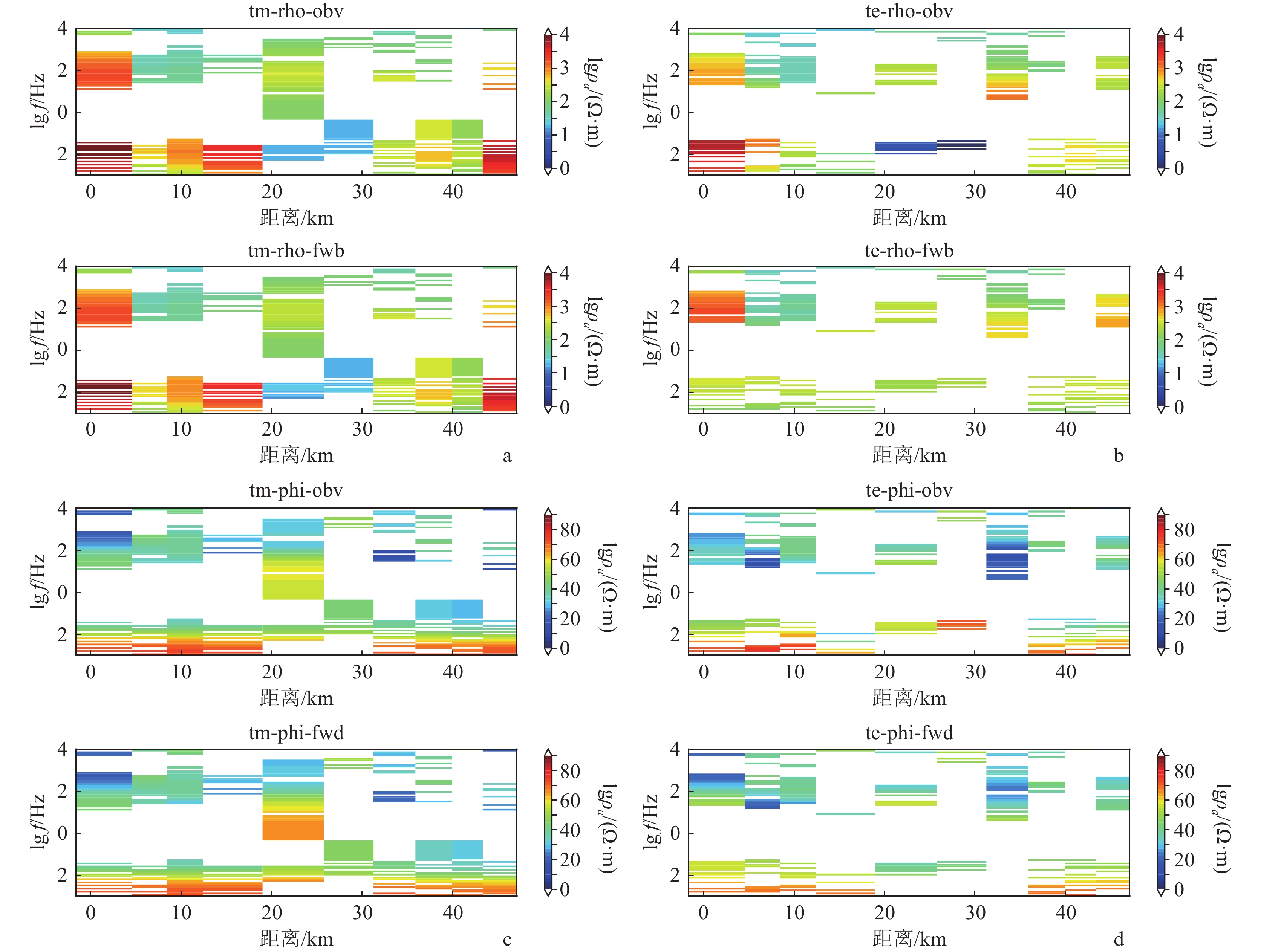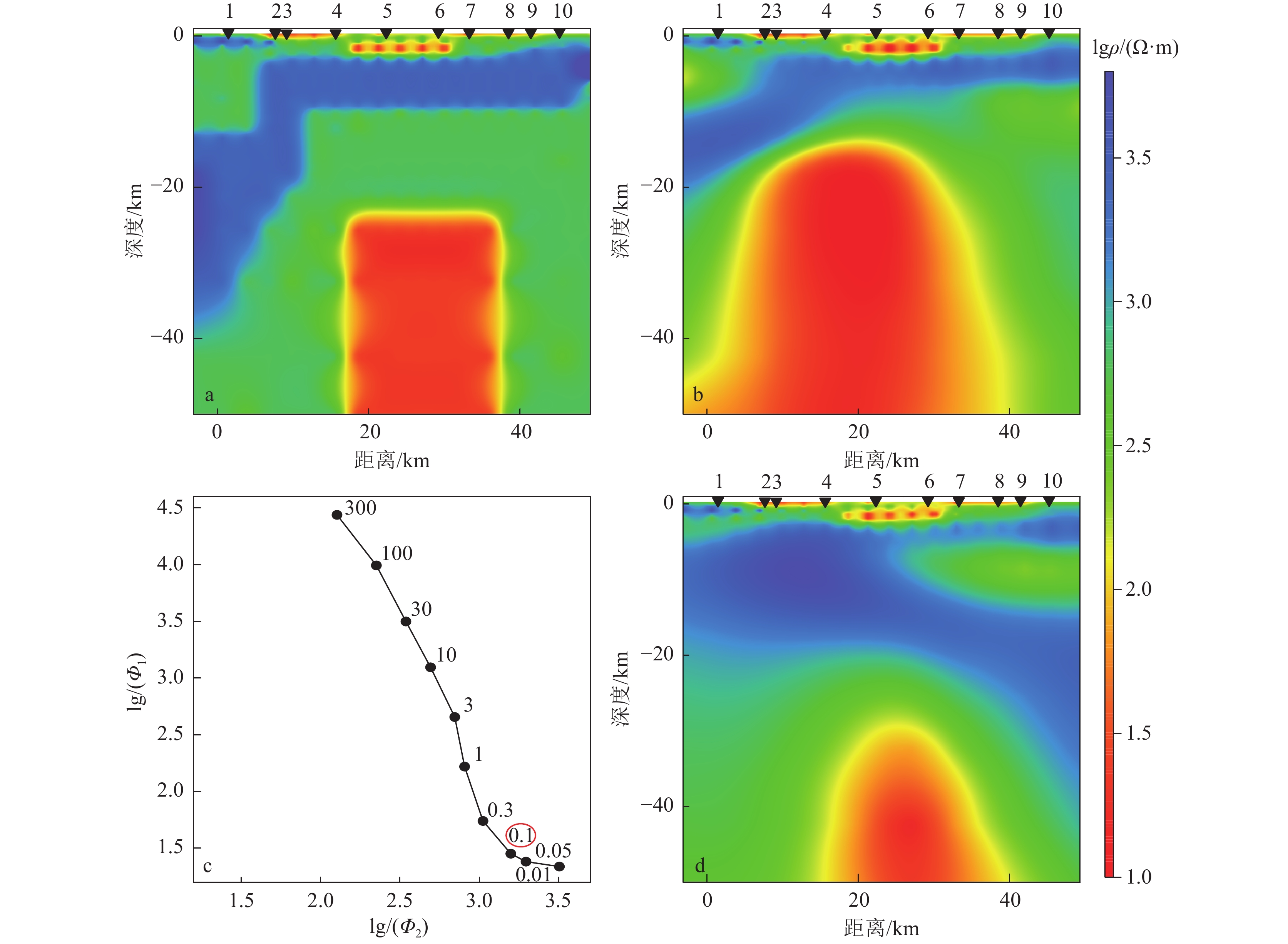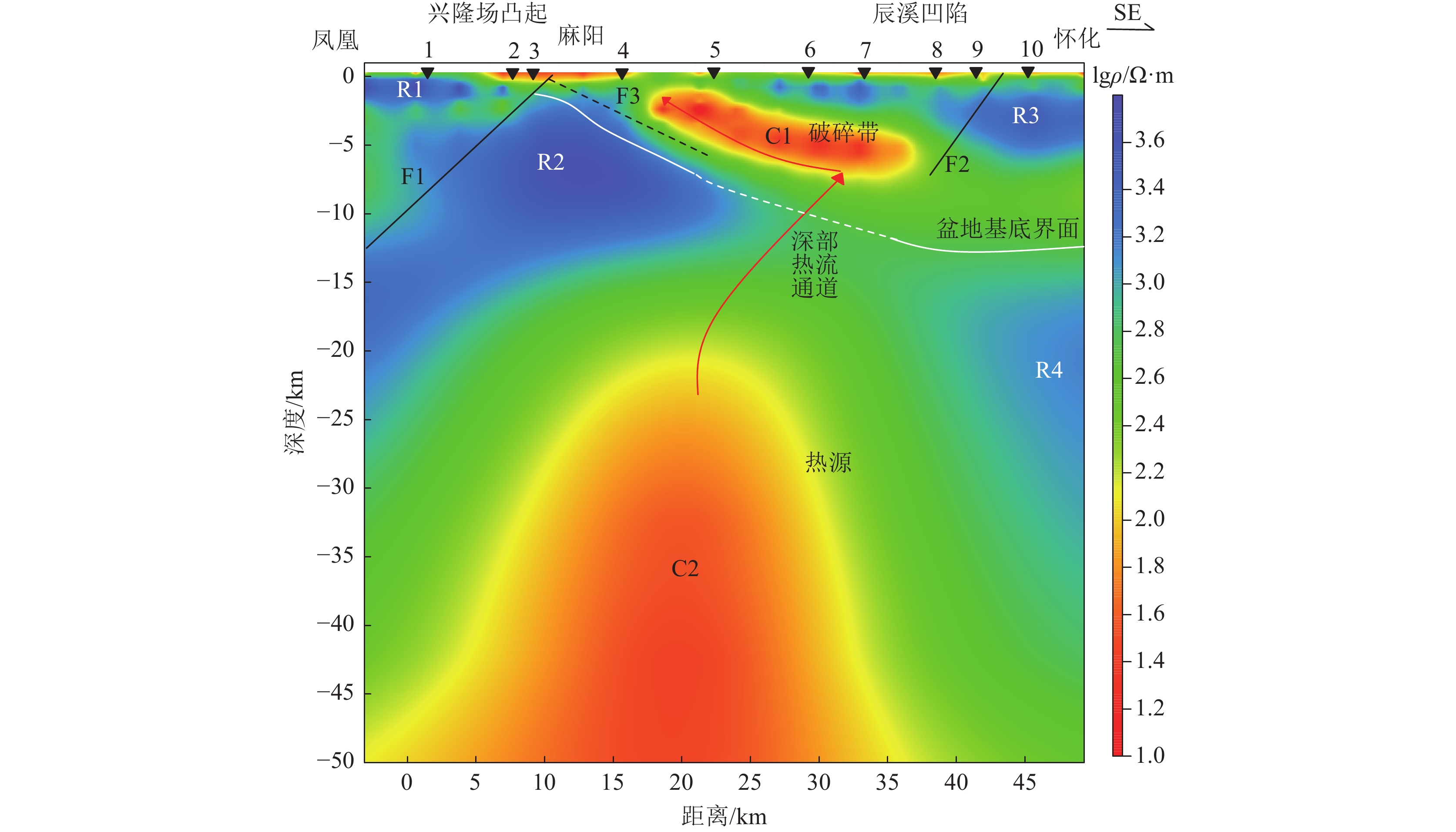Deep electrical characteristics of Mayang Basin,Hunan and its indication to tectonic and geothermal resources
-
摘要:
湖南麻阳盆地位于雪峰山隆起区,地热资源丰富。为了解盆地深部结构,分析地热资源的来源,利用区内同点位采集的音频大地电磁及大地电磁剖面开展二维反演。为保证最终获得的电性结构的可靠性,首先基于相位张量对观测数据开展了维性判别、主轴方位角统计等定性分析确定了张量阻抗旋转角度。然后对比了自适应正则和L曲线正则判优2种反演策略,利用简化模型的正反演试算证明了L曲线策略所得结果更客观真实,并通过L曲线策略反演,获得了麻阳盆地的电性结构模型。最后,结合先验地质信息,识别出3条断裂的深部延展情况,并认为麻阳盆地深部高阻隆起区大致反映了盆地结晶基底隆起的范围。反演所得电性模型显示,麻阳盆地深部存在大范围高导区,推测为部分熔融的热物质,作为深部热源向上传递热量,而浅部存在的高阻体作为盖层,为地热的保存提供了有利条件,二者之间的断裂沟通了浅部和深部,最终,在麻阳县形成温泉。研究结果说明,该带还具有较大的地热资源前景。
Abstract:Mayang Basin in Hunan Province is located in the uplift area of Xuefeng Mountain, which is rich in geothermal resources. In order to understand the deep structure of the basin and analyze the source of geothermal resources, we uses the audio magnetotelluric and magnetotelluric profiles collected at the same point in the area to carry out 2D inversion. To ensure the reliability of the final electrical structure, firstly, based on the phase tensor, the qualitative analysis of the observation data, such as dimension discrimination and spindle azimuth statistics, is carried out to determine the tensor impedance rotation angle. Then, the two inversion strategies of adaptive regularization and L−curve regularization are compared. The forward and inversion trial of the simplified model proves that the results obtained by the L−curve strategy are more objective and real, and the electrical structure model of Mayang Basin is obtained by L−curve strategy inversion. Finally, combined with prior geological information, we identify the deep extension of the three faults, and believe that the deep high−resistance uplift area of the Mayang Basin roughly reflects the range of the basin’s crystalline basement uplift. The electrical model obtained by inversion shows that there is a large−scale high−conductivity area in the deep part of Mayang Basin, which is presumed to be partially melted thermal material that transmits heat upward as a deep heat source, and the high−resistance body in the shallow part serves as a caprock, which provides favorable conditions for geothermal preservation. The fracture between the two links the shallow and deep parts. Finally, a hot spring is formed at Mayang County. Our research shows that the belt also has a great prospect of geothermal resources.
-
Key words:
- Mayang Basin /
- magnetotelluric /
- electrical characteristics /
- geothermal resources
-

-
图 1 麻阳盆地及周缘地质简图(据宋才见等,2016修改)
Figure 1.
-
[1] Amatyakul P, Siripunvaraporn W, Rung−Arunwan T, et al. 2023. A decade of successful magnetotelluric surveys for delineating shallow geothermal reservoirs beneath nonvolcanic hot springs in Thailand[J]. Geophysics, 88(5): WB55−WB69. doi: 10.1190/geo2022-0486.1
[2] Bahr K. 1991. Geological noise in magnetotelluric data: a classification of distortion types[J]. Phys. Earth Planet. Int., 66(1/2): 24−38. doi: 10.1016/0031-9201(91)90101-M
[3] Bai D Y, Jiang W, Zhong X, et al. 2015. Mesozoic−Cenozoic structural deformation characteristics of Yuanling−Mayang basin and regional tectonic setting[J]. Geology in China, 42(6): 1851−1875 (in Chinese with English abstract).
[4] Cai J T, Chen X B, Zhao G Z. 2010. Refined techniques for data processing and two−dimensional inversion in magnetotelluric I: Tensor decomposition and dimensionality analysis[J]. Chinese J. Geophys., 53(10): 2516−2526 (in Chinese with English abstract).
[5] Caldwell T G, Bibby H M, Brown C. 2004. The magnetotelluric phase tensor[J]. Geophysical Journal International, 158(2): 457−469. doi: 10.1111/j.1365-246X.2004.02281.x
[6] Chave A D, Jones A G. 2012. The Magnetotelluric Method: Theory and Practice[M]. Cambridge: Cambridge University Press: 10−11.
[7] Chen X B, Ye T, Cai J T, et al. 2019. Refined techniques for data processing and two−dimensional inversion in magnetotelluric (VII): Electrical structure and seismogenic environment of Yingjiang−Longling seismic area[J]. Chinese J. Geophys., 62(4): 1377−1393 (in Chinese with English abstract).
[8] Chen X B, Zhao G Z, Tang J, et al. 2005. An adaptive regularized inversion algorithm for magnetotelluric data[J]. Chinese J. Geophys., 48(4): 937−946 (in Chinese with English abstract).
[9] Cheng J W, 2015. The regional gravity and magnetic−based potential prediction of matal deposits in Huaihua district, Hunan province[J]. Contributions to Geology and Mineral Resources Research, 30(3): 435−442 (in Chinese with English abstract).
[10] Cui J J, Shi W, Dong S W, et al. 2020. The discovery of confined hot water and high quality hydrocarbon source rocks in pilot scientific drill hole of Xuefeng Mountain area[J]. Geology in China, 47(4): 1268−1269 (in Chinese with English abstract).
[11] Deng Y, Tang J, Ruan S. 2019. Adaptive regularized three−dimensional magnetotelluric inversion based on the LBFGS quasi−Newton method[J]. Chinese J. Geophys., 62(9): 3601−3614 (in Chinese with English abstract).
[12] Fang H, Zhong Q, Li X C, et al. 2013. The development of Linxi Formation in the depth of Zhalute basin: Evidence from magnetotelluric sounding[J]. Geological Bulletin of China, 32(8): 1289−1267 (in Chinese with English abstract).
[13] Fu S Y, Li Z H, Zheng Z F. 2012. Metallogenic forecast for the mercury−lead−zing deposits in Fenghuang−Mayang area of Hunan province[J]. Geology and Resources, 21(3): 289−295 (in Chinese with English abstract).
[14] Groom R W, Bailey R C. 1989. Decomposition of magnetotelluric impedance tensors in the presence of local three−dimensional galvanic distortion[J]. Journal of Geophysical Research: Solid Earth, 94(B2): 1913−1925. doi: 10.1029/JB094iB02p01913
[15] Hansen P C. 1992. Analysis of discrete ill−posed problems by means of the L−curve[J]. SIAM review, 34(4): 561−580. doi: 10.1137/1034115
[16] Jiang H K, Zhan S Q, Wang H X. 1992. The deep geoelectrical characteristics in Dazu, Sichuan−Quanzhou, Fujian[J]. Acta Geophysica Sinica, (2): 214−222 (in Chinese with English abstract).
[17] Krieger L, Peacock J R. 2014. MTpy: A Python toolbox for magnetotellurics[J]. Computers & Geosciences, 72: 167−175.
[18] Kuang W L, Xiang S C, Xiao W Z, et al. 2015. Metallogenic geological characteristics and genesis of lead−zinc deposits in northwestern Hunan[J]. Mineral Deposits, 34(5): 1072−1082 (in Chinese with English abstract).
[19] Li Q G, Yan J H, Wen T, et al. 2016. Shale gas exploration prospect of Niutitang formation in Yuanma basin[J]. Petroleum Geology and Engineering, 30(5): 6−11, 138 (in Chinese with English abstract).
[20] Li S Q. 2019. Study for electrical structure of Xuefeng mountain basement uplift and its western margin[D]. Master’s Thesis of China University of Geosciences (Beijing) (in Chinese with English abstract).
[21] Lin C. 2021. Research on the deep electrical structure of the middle section of Jiangnan Orogen −Xuefeng Mountain structural belt and its adjacent area[D]. Master’s Thesis of China University of Geosciences (Beijing) (in Chinese with English abstract).
[22] Liu H L, Chen C T, Fan J J, et al. 2024. Deep electrical structure of Qilian to Alxa block in northeastern margin of Qinghai−Tibet Plateau and its geological significance[J]. Progress in Geophysics, 39(3): 916−929 (in Chinese with English abstract).
[23] Liu M M. 2015. Geological characteristics of Lower Cambrian shale−gas reservoir, Yuanma area[J]. Natural Gas Technology and Economy, 9(3): 18−21, 77 (in Chinese with English abstract).
[24] Luo W, Sun N, Wei H J. 2015. Geological characteristics and ore−control condition of sandstone−type copper deposit in Yuanma Basin, Hunan province[J]. China Mining Magazine, 24(9): 72−79 (in Chinese with English abstract).
[25] Niu P, Han J T, Zeng Z F, et al. 2021. Deep controlling factors of the geothermal field in the northern Songliao basin derived from magnetotelluric survey[J]. Chinese J. Geophys., 64(11): 4060−4074 (in Chinese with English abstract).
[26] Peng T P, Li C W, Peng B X. 2002. Tectonic constraints on the underground thermal−water resources in Hunan province and its perstective for exploration[J]. Hunan Geology, (1): 56−60 (in Chinese with English abstract).
[27] Peng Z Q. 2019. Geological conditions and exploration potential of shale gas in the Niutitang Formation of the Lower Cambrian in the Yuanma basin and its periphery area[D]. Doctoral Dissertation of China University of Geosciences (Wuhan) (in Chinese with English abstract).
[28] Rao J R. 1999. Deep structural geology setting and metallogenic forecasting of primary diamond in Hunan[J]. Hunan Geology, (1): 23−30 (in Chinese with English abstract).
[29] Rodi W, Mackie R L. 2001. Nonlinear conjugate gradients algorithm for 2−D magnetotelluric inversion[J]. Geophysics, 66(1): 174−187. doi: 10.1190/1.1444893
[30] Ruan S. 2020. On improvements of Quasi−Newton typed three−dimensional magnetotelluric inversion[R]. Institute of Geology, China Earthquake Administration (in Chinese with English abstract).
[31] Song C J, He H L. 2016. Geophysical study of deep structure in Mayang basin, Hunan Provicne[J]. Geophysical and Geochemical Exploration, 40(6): 1089−1096 (in Chinese with English abstract).
[32] Swift C M J. 1967. A magnetotelluric investigation of an electrical conductivity anomaly in the southwestern United States[D]. Doctoral Dissertation of Massachusetts Institute of Technology.
[33] Tong Y S, Tong Q. 2012. Relationship between deep geophysical field features and earthquakes in Hunan province[J]. Plateau Earthquake Research, 24(1): 1−10 (in Chinese with English abstract).
[34] Wang D P, Zhang Q, Guo G L, et al. 2014. Element geochemistry and its genetic significance of native copper mineralization in the Mayang Deposit, Hunan Province, China[J]. Journal of Jilin University (Earth Science Edition), 44(4): 1177−1187 (in Chinese with English abstract).
[35] Wang Q N, Li T, Zhu J B. 2012. Deep structure characteristics on the western side of the Xuefeng Mountain: New evidence from magnetotelluric (MT) sounding[J]. Geological Bulletin of China, 31(11): 1826−1837 (in Chinese with English abstract).
[36] Weaver J T, Agarwal A K, Lilley F E M. 2006. The relationship between the magnetotelluric tensor invariants and the phase tensor of Caldwell, Bibby, and Brown[J]. Exploration Geophysics, 37(3): 261−267. doi: 10.1071/EG06261
[37] Xie X H, Tang L, Ruan S, et al. 2023. Optimal 2D inversion strategy for large scale magnetotelluric profile in south China[J]. Computing Techniques for Geophysical and Geochemical Exploration, 45(2): 221−234 (in Chinese with English abstract).
[38] Yang H, Sun X, Zhan Y, et al. 2024. New magnetotelluric data reveal deep fault boundaries and contrasting late cenozoic fault kinematics between the Qilian Shan thrust wedge and Beishan‐Alxa block, western China[J]. Geophysical Research Letters, 51(5): e2023GL107659. doi: 10.1029/2023GL107659
[39] Yang S X , Lao K T. 2007. Geological characteristics and ore indicators of lead− zinc deposits in northwestern Hunan, China[J]. Geological Bulletin of China, (7): 899−908 (in Chinese with English abstract).
[40] Yuan X C, Hua J R. 2011. 3D Lithospheric structure of South China[J]. Geology in China, 38(1): 1−19 (in Chinese with English abstract).
[41] Zeng Y. 2007. Ore−control condition of sandstone−type copper deposit in Yuanma Basin, Hunan province[J]. Land & Resources Herald, (3): 24−26 (in Chinese with English abstract).
[42] Zhao B F, Wang Q N, Guan D W, et al. 2022. Temperature field characteristics and thermal control factors of banded reservoirs geothermal field: an example of Reshui−town geothermal field, Hunan Province[J]. Geological Bulletin of China, 41(11): 2035−2046 (in Chinese with English abstract).
[43] Zhao W J, Zhao H Q, Guo X D, et al. 2016. Magnetotelluric sounding in the Jingxin Basin, Jilin, China[J]. Progress in Geophysics, 31(4): 1542−1549 (in Chinese with English abstract).
[44] Zheng W, Wang Y L, Xiao Y, et al. 2021. Frequency−band merging of AMT and MT data and the application to geothermal resources exploration[J]. Contributions to Geology and Mineral Resources Research, 36(3): 388−394 (in Chinese with English abstract).
[45] 柏道远, 姜文, 钟响, 等. 2015. 湘西沅麻盆地中新生代构造变形特征及区域地质背景[J]. 中国地质, 42(6): 1851−1875.
[46] 蔡军涛, 陈小斌, 赵国泽. 2010. 大地电磁资料精细处理和二维反演解释技术研究(一)——阻抗张量分解与构造维性分析[J]. 地球物理学报, 53(10): 2516−2526. doi: 10.3969/j.issn.0001-5733.2010.10.025
[47] 陈小斌, 赵国泽, 汤吉, 等. 2005. 大地电磁自适应正则化反演算法[J]. 地球物理学报, (4): 937−946. doi: 10.3321/j.issn:0001-5733.2005.04.029
[48] 陈小斌, 叶涛, 蔡军涛, 等. 2019. 大地电磁资料精细处理和二维反演解释技术研究(七)——云南盈江—龙陵地震区深部电性结构及孕震环境. 地球物理学报, 62(4): 1377−1393.
[49] 成剑文. 2015. 基于区域重磁信息的湖南怀化地区金属成矿预测[J]. 地质找矿论丛, 30(3): 435−442. doi: 10.6053/j.issn.1001-1412.2015.03.017
[50] 崔建军, 施炜, 董树文, 等. 2020. 雪峰山科学钻先导孔发现承压热水层和优质烃源岩[J]. 中国地质, 47(4): 1268−1269.
[51] 邓琰, 汤吉, 阮帅. 2019. 三维大地电磁自适应正则化有限内存拟牛顿反演[J]. 地球物理学报, 62(9): 3601−3614. doi: 10.6038/cjg2019M0045
[52] 方慧, 钟清, 李晓昌, 等. 2013. 内蒙古扎鲁特盆地深部林西组发育特征——来自大地电磁探测的依据[J]. 地质通报, 32(8): 1289−1296. doi: 10.3969/j.issn.1671-2552.2013.08.016
[53] 付胜云, 李泽泓, 郑正福. 2012. 湖南省凤凰—麻阳地区汞铅锌矿成矿预测[J]. 地质与资源, 21(3): 289−295. doi: 10.3969/j.issn.1671-1947.2012.03.007
[54] 蒋洪堪, 战双庆, 王宏勋. 1992. 四川大足—福建泉州深部地电特征[J]. 地球物理学报, (2): 214−222. doi: 10.3321/j.issn:0001-5733.1992.02.010
[55] 匡文龙, 向世超, 肖文舟, 等. 2015. 湘西北地区铅锌矿床成矿地质特征及矿床成因研究[J]. 矿床地质, 34(5): 1072−1082.
[56] 李启桂, 燕继红, 闻涛, 等. 2016. 沅麻盆地牛蹄塘组页岩气勘探前景分析[J]. 石油地质与工程, 30(5): 6−11, 138. doi: 10.3969/j.issn.1673-8217.2016.05.002
[57] 李树强. 2019. 雪峰山基底隆起区及其西缘电性结构研究[D]. 中国地质大学(北京)硕士学位论文.
[58] 林川. 2021. 江南造山带中段雪峰山构造带及其邻区深部电性结构研究[D] . 中国地质大学(北京)硕士学位论文.
[59] 刘会龙, 陈楚桐, 范俊杰, 等. 2024. 青藏高原东北缘祁连至阿拉善地块深部电性结构特征及其地质意义[J]. 地球物理学进展, 39(3): 916−929. doi: 10.6038/pg2024HH0232
[60] 刘苗苗. 2015. 沅麻盆地下寒武统页岩气油气地质特征[J]. 天然气技术与经济, 9(3): 18−21, 77. doi: 10.3969/j.issn.2095-1132.2015.03.005
[61] 罗卫, 孙宁, 魏红军. 2015. 沅麻盆地砂岩型铜矿成矿地质特征及其控矿条件研究[J]. 中国矿业, 24(9): 72−79. doi: 10.3969/j.issn.1004-4051.2015.09.020
[62] 牛璞, 韩江涛, 曾昭发, 等. 2021. 松辽盆地北部地热场深部控制因素研究: 基于大地电磁探测的结果[J]. 地球物理学报, 64(11): 4060−4074. doi: 10.6038/cjg2021O0453
[63] 彭头平, 李超文, 彭冰霞. 2002. 湖南地热资源的构造制约与勘查标志[J]. 湖南地质, (1): 56−60.
[64] 彭中勤. 2019. 沅麻盆地周缘下寒武统牛蹄塘组页岩气地质条件及勘探潜力[D]. 中国地质大学(武汉)博士学位论文.
[65] 饶家荣. 1999. 湖南原生金刚石矿深部构造地质背景及成矿预测[J]. 湖南地质, (1): 23−30.
[66] 阮帅. 2020. 拟牛顿型三维大地电磁反演方法改进研究[R]. 中国地震局地质研究所.
[67] 宋才见, 贺华霖. 2016. 湖南麻阳盆地深部结构的地球物理研究[J]. 物探与化探, 40(6): 1089−1096.
[68] 童迎世, 童琼. 2012. 湖南深部地球物理场特征与地震的关系[J]. 高原地震, 24(1): 1−10. doi: 10.3969/j.issn.1005-586X.2012.01.001
[69] 王大鹏, 张乾, 郭国林, 等. 2014. 湖南麻阳砂岩自然铜矿床元素地球化学及其成因意义[J]. 吉林大学学报(地球科学版), 44(4): 1177−1187.
[70] 汪启年, 李涛, 朱将波. 2012. 雪峰山西侧深部构造的特征——来自大地电磁测深(MT)的新证据[J]. 地质通报, 31(11): 1826−1837. doi: 10.3969/j.issn.1671-2552.2012.11.007
[71] 谢学华, 汤力, 阮帅, 等. 2023. 华南超大尺度大地电磁剖面最佳二维反演策略研究[J]. 物探化探计算技术, 45(2): 221−234. doi: 10.3969/j.issn.1001-1749.2023.02.11
[72] 杨绍祥, 劳可通. 2007. 湘西北铅锌矿床的地质特征及找矿标志[J]. 地质通报, (7): 899−908. doi: 10.3969/j.issn.1671-2552.2007.07.015
[73] 袁学诚, 华九如. 2011. 华南岩石圈三维结构[J]. 中国地质, 38(1): 1−19. doi: 10.3969/j.issn.1000-3657.2011.01.001
[74] 曾勇. 2007. 沅麻盆地砂岩型铜矿控矿条件[J]. 国土资源导刊, (3): 24−26. doi: 10.3969/j.issn.1672-5603.2007.03.007
[75] 赵宝峰, 汪启年, 官大维, 等. 2022. 带状热储地热田温度场特征及控热因素——以湖南省汝城县热水圩地热田为例[J]. 地质通报, 41(11): 2035−2046. doi: 10.12097/j.issn.1671-2552.2022.11.012
[76] 赵维俊, 赵海卿, 郭晓东, 等. 2016. 吉林省珲春市敬信盆地大地电磁探测[J]. 地球物理学进展, 31(4): 1542−1549. doi: 10.6038/pg20160417
[77] 郑伟, 王阳玲, 肖扬, 等. 2021. AMT和MT数据频带拼接技术及其在地热资源勘探中的应用[J]. 地质找矿论丛, 36(3): 388−394. doi: 10.6053/j.issn.1001-1412.2021.03.016
-



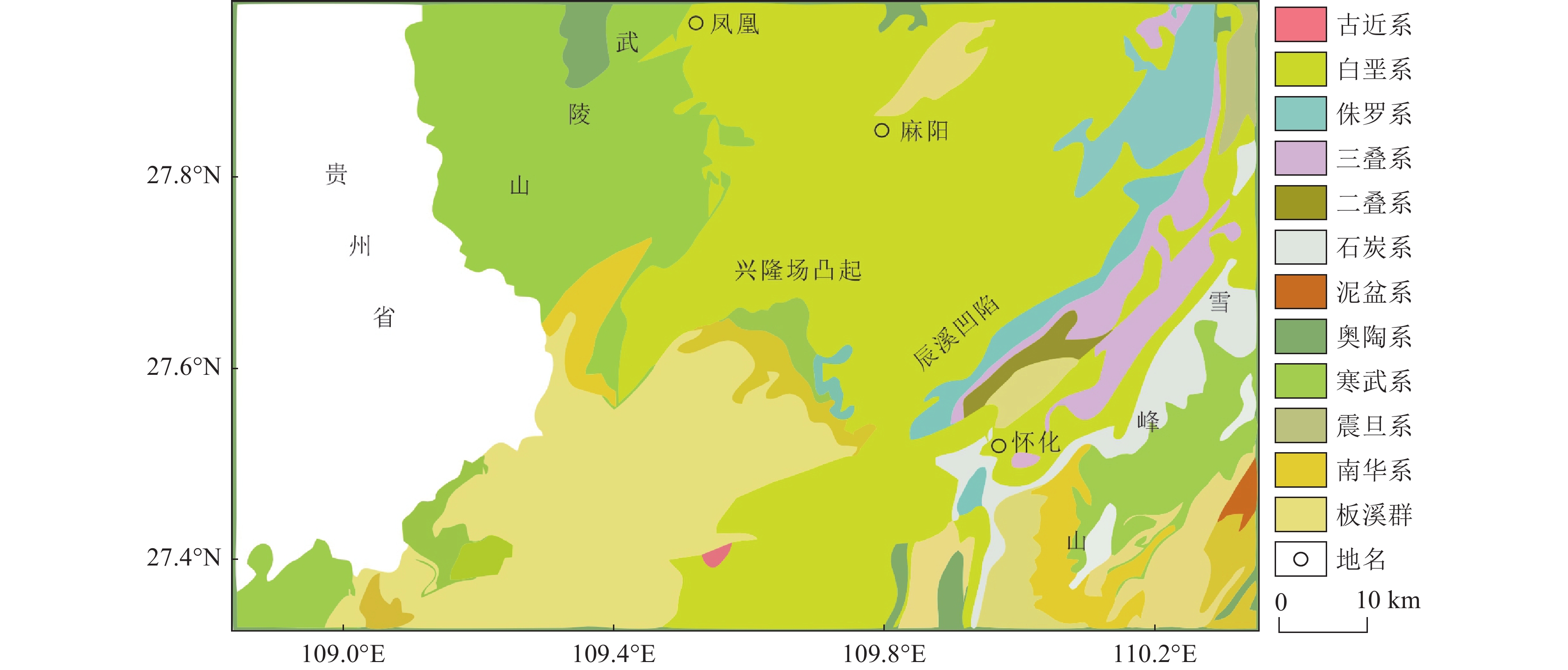
 下载:
下载:
